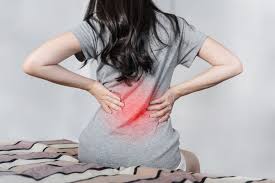Understanding Low Back Pain: Trigger Points vs. Disc Herniation 🌟🤷♀️
👋🏻Understanding two common causes of low back pain: trigger points and disc herniation. Both can be sources of discomfort, but they differ in their origin, symptoms, and treatment approaches.🤗

| 🧐Trigger Points and Referred Pain 💢 Trigger points are hyperirritable spots within a muscle that can cause local or referred pain. In the context of the lower back, trigger points often develop in muscles such as the quadratus lumborum, gluteals, and erector spinae. These points can cause pain not only at the site but also refer pain to other areas, making diagnosis challenging. The referred pain from trigger points can manifest in the buttocks, hips, or even down the legs. This phenomenon often leads to confusion as the pain is felt in a different area from where the trigger point exists. Activities like prolonged sitting, poor posture, or repetitive movements can aggravate trigger points, exacerbating the discomfort. |
| Disc Herniation and Radiculopathy 🔄 On the other hand, disc herniation involves the rupture or bulging of the intervertebral discs, resulting in the compression or irritation of spinal nerves. When the herniated disc material presses on a nerve root, it leads to radiculopathy—commonly known as sciatica when occurring in the lower back. Radiculopathy from disc herniation often presents as sharp, shooting pain that travels along the path of the affected nerve. It can be accompanied by numbness, tingling, or weakness in the legs, impacting mobility and daily activities. |

Distinguishing Between the Two 🎯
Differentiating between trigger point pain and radiculopathy from disc herniation can be challenging due to overlapping symptoms. However, certain signs can help differentiate:
- Nature of Pain: Trigger point pain is often localized and can be reproduced by palpating the affected muscle, while radiculopathy from disc herniation tends to radiate along specific nerve pathways.
- Associated Symptoms: Disc herniation may present with neurological symptoms like numbness, tingling, or weakness, which are less common in trigger point pain.
- Onset and Aggravating Factors: Disc herniation symptoms can worsen with certain movements like bending or lifting, while trigger point pain may worsen with sustained postures or repetitive activities.
Treatment Approaches 💆♂️
Treatment for trigger points typically involves spine therapy, massage, stretching, and addressing contributing factors like poor posture or muscle imbalances. On the other hand, management of disc herniation might involve a combination of conservative measures (rest, spine therapy, medication) and in severe cases, surgical intervention may be considered.
Conclusion 🌈
Understanding the nuances between trigger point pain and disc herniation-induced radiculopathy is crucial for accurate diagnosis and effective treatment.
